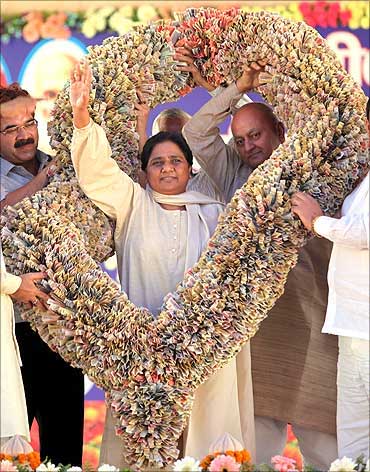Arvind Singhal
India, or at least Indian economy, seems to be shining bright like never before, writes Arvind Singhal.
India, or at least Indian economy, seems to be shining bright like never before.
Beyond billion and multi-billion-dollar business deals on a regular basis, the stock market indices are at all-time high levels, real estate prices have touched stratospheric levels with the biggest boom in ultra-luxury apartments, annualised domestic sales of automobiles have crossed the two-million mark with big gains coming not only for the entry-level vehicles but also for the premium and luxury ones, and magazines are now full of advertisements for ultra-expensive jewellery, wrist-wear, pens and other accessories.
Land parcel auctions now regularly beat the reserve prices by handsome margins and 1,000 crore ( 10 billion) or higher transactions no longer attract the same attention in the financial media as the one or two that happened some years ago did.
Indeed, even the interest, if not actual demand, for personal aircraft and private yachts seems to be seeing a surge.
Finally, India is now frequently seeing a number of very large investment projects by relatively unknown promoters being launched.
...
How they are fuelling India's economic growth
Photographs: Uttam Ghosh/Rediff.com
Is all this wealth being created through entrepreneurial start-ups and their success, rapidly rising executive compensation, and ESOPs?
Or, could there be the beginning of a strong emergence of another class of HNIs (high net worth individuals) and another class of "private equity" who are finding it more attractive (or convenient) to consume or invest in India?
Indeed, there could be some insights into where and how this unprecedented wealth creation may be happening when deputy managers in dairy federations in states like Rajasthan are able to stash away Rs 5 crore (Rs 50 million) or more in their bank lockers, when judges fraudulently withdraw crores of rupees from PF accounts, when companies can be given shady contracts to earn tens and hundreds of crores of rupees for doing almost nothing as are being reported almost daily in the context of the Commonwealth Games, when the largesse of some sections of the government runs purportedly into tens of thousands of crores relating to "auction" or "allotment" of public assets like telecom spectrum, making some of the beneficiaries overnight billionaires, or at least multi-millionaires (in dollar or euro terms), when PDS rice and other essential commodities are siphoned off the distribution system and resold at stupendous gains, when politicians and their friends are able to audaciously mine and loot national wealth with impunity and then some even make it to ministerial positions, and when PPP (public-private partnership) becomes synonymous with crony-capitalism, giving a whole new meaning to it: public money for private parties.
...
How they are fuelling India's economic growth
Image: Uttar Pradesh Chief Minister Mayawati with a garland of currency notes.Photographs: Reuters
India always had a parallel economy, and at the best of times, there was substantial generation of unaccounted wealth through evasion of taxes and through undeclared commissions on purchases of projects and machinery, and perhaps aviation and defence equipment too.
The commissions were mostly directly remitted to offshore accounts, while domestic tax evasion found its way into some local as well as overseas spending and investment through monies remitted through hawala means.
What has changed now, if one were to believe what is now routinely reported in the media, is the sheer scale of corruption, the size of transactions and the quantum of monies involved.
When the money involved runs into tens, hundreds, and thousands of crores for each or a series of similar deals, it is practically impossible to move such sums out of India through any legitimate or illegitimate channel.
Hence, it is likely that some or a large part of this money is finding its way back into the Indian economy itself not only through "investment" in flats costing tens of crores (sometimes even more than 100 crore or 1 billion), and consumption of ultra-luxury goods and services, but also through private equity that is being put up for launch of new businesses, and even through the Indian stock markets by way of scores of funds that are now being regularly launched.
...
How they are fuelling India's economic growth
Photographs: Uttam Ghosh.Rediff.com
This may not be very different from what is well known in countries that have very strong income generation through "sin" businesses - such incomes are ultimately channelled into legitimate businesses.
In the normal course, this may not have been all that bad - at least the Indian money remains in India.
However, the big potential downside is that this new class of investors and consumers has no acquisition cost (or effort) of this capital and hence there could be distortions in fair pricing of some asset classes such as premium and luxury real estate, distortions in demand assessment for premium and luxury consumer products, distortions in equity markets, and worse, bigger distortions in the business environment itself where the risk of easy money could create business practices that are not consistent with rational behaviour if the market cost of capital were to be applied.






article